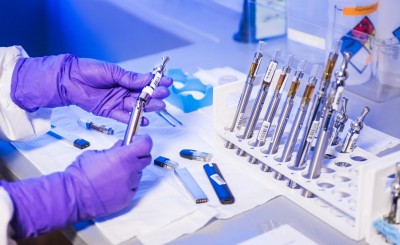Health & Medicine
Progress on Medical Brain-Machine Interfaces for Neuro-Prosthetics
Mark Hoffman
First Posted: Jan 25, 2013 02:23 PM EST
First Posted: Jan 25, 2013 02:23 PM EST
The development of non-invasive brain-machine interfaces for machines meant to help patients suffering from severe motor impairments is being advanced by a large European research program. Three of the technologies developed within the framework of TOBI were publicly presented at the closing seminar of the research program that just took place in Sion from 23 to 25 January 2013.
The TOBI project (Tools for brain-computer interaction, www.tobi-project.org) is financed by the European Commission and was coordinated by the Swiss Polytechnical University of Lausanne, EPFL, for the past four years.
More than a hundred patients suffering from severe motor impairments, which means the partial or complete inability to move one or more of their limbs, have voluntarily participated in the various projects, and had the opportunity to test the devices. The main purpose of these machines is usally to allow the patients either regain some of their mobility or improve their social relationships.
A well known mechanism is used, detecting signals transmitted by the brain with electroencephalography (EEG) through electrodes placed in a cap worn by the patient. The signals form different patterns, depending on what thought or action the individual focuses, which then needs to be analyzed and correctly translated by a computer to turn the signals into concrete actions. But to optimize this process, in order to make it faster, more precise, more versatile is the big challenge that is tackled by the many researchers and institutions working together in the TOBI project. As a result, they could now present the following three technologies:
- Robotino, for helping rebuild social ties when bedridden. Combining EEG, signal recognition, obstacle sensors and the internet, researchers have been able to develop a small robot equipped with a camera and a screen that can be controlled remotely by physically disabled people. Thanks to this device, the patient can take a virtual walk in a familiar environment, meet her/his relatives and talk to them, even if they are thousands of miles away from each other.
- Braintree, for writing texts and internet surfing. Researchers have also developed a graphical interface specially adapted for web browsing by severely disabled people. By thinking, the patient is able to move a cursor in a tree structure in order to type a character or choose a command. Depending on the specific situation, the sensors can also detect residual muscular activity to complement the management of the device.
- Functional electrical stimulation, to restore some basic mobility. Coupling EEG with electrical muscle stimulation can allow a patient to voluntarily control the movement of a paralyzed limb. In some cases, intensive training using this system has allowed the patients to regain control of the limb and keep it without assistance.
"Our results are already very promising," says José del R. Millán, professor at the Centre for Neuroprosthetics (CNP) at EPFL, holder of the Defitech Foundation Chair in Non-Invasive Brain-Machine Interface and TOBI project coordinator. Nevertheless, he adds: "The road is still long before the "turnkey" product is made available to physicians and patients. Each brain has its own way of transmitting its signals and the devices' calibration requires the investment of significant resources. However, we have paved the way for a new critical approach to the physical and social rehabilitation of patients."
See Now: NASA's Juno Spacecraft's Rendezvous With Jupiter's Mammoth Cyclone



